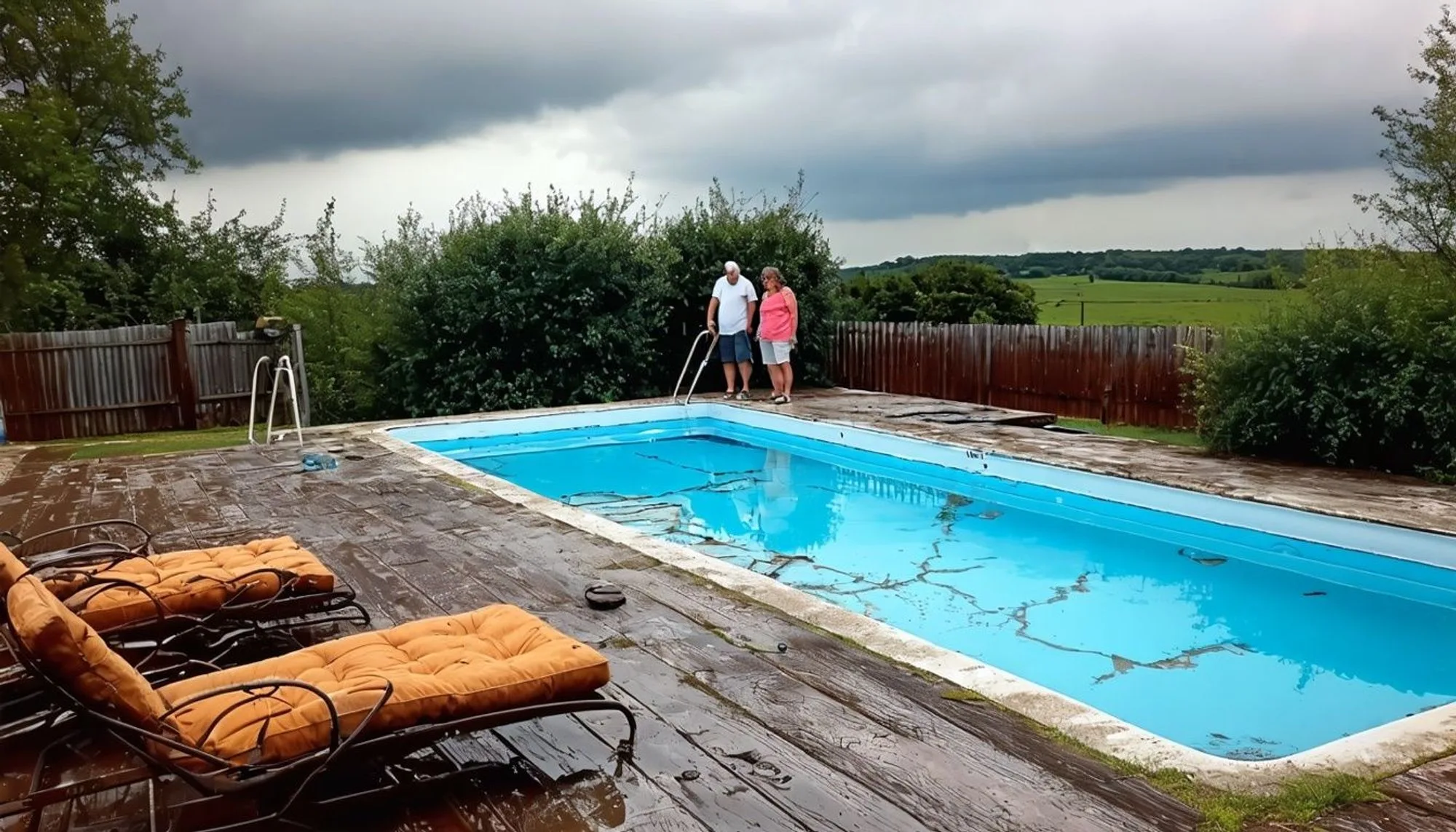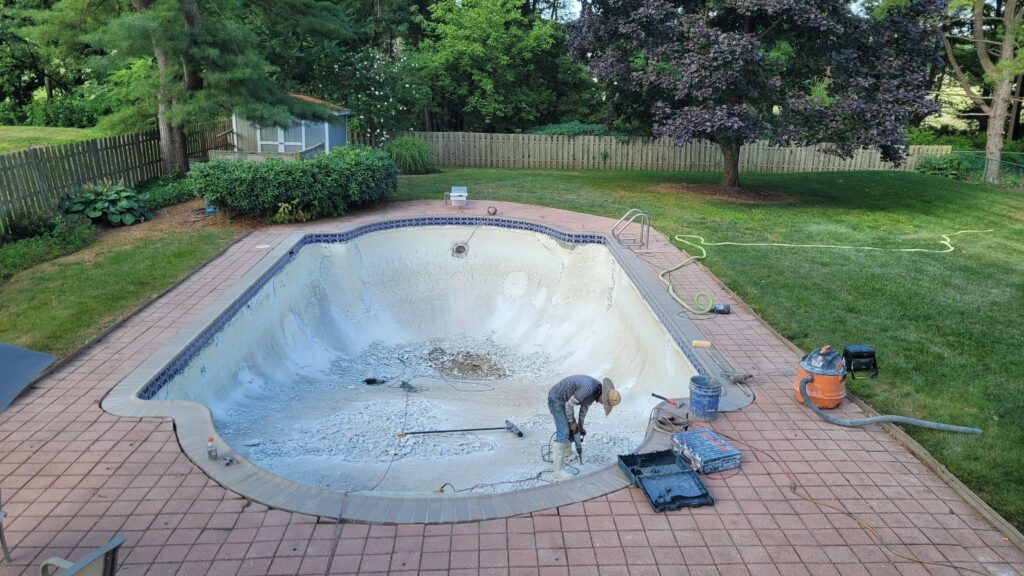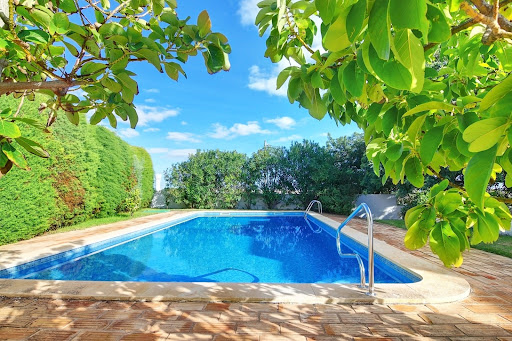Why Would a Pool Need to be Resurfaced?

Your pool might be looking a bit weary, signaling it’s time for a refresh. Resurfacing a pool is crucial for maintaining its longevity and ensuring it remains a family favorite spot.
This article will guide you through understanding why your swimming sanctuary may need an overhaul and how it contributes to both its functionality and appearance.
Signs That Indicate the Need for Pool Resurfacing
Stains on the pool surface and flaking or discolored plaster are clear signs of the need for pool resurfacing. Visible erosion marks, constantly dropping water level, cracks in the pool’s walls, and loss of pebbles or fiberglass material also indicate the need for resurfacing.
Stains on the pool surface
Stains on the pool surface can signal a need for resurfacing. These marks often come from algae, leaves, and other debris. They might look like dark spots or patches across the plaster or fiberglass.
While some stains fade with cleaning, others sink deeper into the surface over time. Fiberglass pools have an advantage here; their stains are not permanent and easier to manage with regular maintenance.
Persistent stains degrade your pool’s appearance and suggest underlying issues. For instance, metal objects left in the water can rust and leave behind hard-to-remove marks. Chemical imbalances in your pool water also contribute to staining by allowing minerals to deposit on the walls and floor.
Addressing these signs early helps maintain your swimming pool’s beauty and functionality. Resurfacing eliminates these blemishes, restoring a clean, inviting look while protecting against future damage.
Constantly dropping water level
Pools needing resurfacing often exhibit constantly dropping water levels, a common sign of leaks and erosion. The loss of water can indicate underlying damage to the pool’s surface, requiring prompt attention for preservation.
Leaks might result from cracks or eroded plaster, emphasizing the crucial aspect of maintaining the pool’s surface integrity to avoid unnecessary water loss and potential extensive repairs.
Visible drops in the water level can be indicative of more severe issues with the pool’s structure. Prompt action is required to address these concerns effectively, ensuring sustainable usage and enjoyment of the swimming pool.
Visible erosion marks on the pool surface

Visible erosion marks on the pool surface indicate wear and tear, affecting the pool’s appearance. Erosion can occur due to various factors like chemical imbalances, incorrect water chemistry maintenance, or prolonged exposure to harsh weather conditions.
Over time, these marks can worsen, leading to structural damage if not addressed promptly. Resurfacing a pool can address visible erosion marks effectively by restoring the surface to its original condition. It also provides an opportunity to correct any underlying issues contributing to erosion, ensuring the longevity of the pool surface.
Flaking or discolored plaster
Flaking or discolored plaster in a pool is a clear sign that the pool needs resurfacing. Over time, the plaster can deteriorate due to exposure to chemicals and sunlight, leading to flaking and discoloration.
This affects not only the appearance but also the structural integrity of the pool. Addressing this issue promptly through professional resurfacing will help restore the pool’s surface.
Cracks in the pool’s walls
When it comes to signs that a pool needs resurfacing, cracks in the pool’s walls are a clear indication of potential problems. These cracks can lead to water leakage and further damage if not addressed promptly.
Additionally, they can be caused by various factors such as ground movement or poor construction materials. It is essential to address these issues with prompt pool resurfacing to prevent further deterioration and maintain the structural integrity of the pool.
Factors That Affect the Lifespan of a Pool’s Surface
The pool surface lifespan can be affected by the amount of sunlight it is exposed to. The type of chemicals used in the pool also influences how long the surface will last.
Amount of sunlight exposure
The amount of sunlight exposure significantly affects a pool’s surface lifespan. Prolonged exposure to direct sunlight can cause the surface material to fade and degrade more quickly, leading to the need for resurfacing sooner. It also accelerates chemical breakdown in some cases, reducing the overall integrity of the pool’s surface.

Chemicals used in the pool
Chlorine is the most common chemical used in pool maintenance to kill bacteria and algae. However, high levels of chlorine can accelerate the wear and tear on pool surfaces, leading to discoloration, fading, and etching.
The pH level of pool water should ideally be between 7.2 and 7.8. Low pH levels make the water acidic, which can corrode metal fixtures and cause the pool surface to become rough and etched. High pH levels, on the other hand, can lead to scaling and deposits that mar the surface.
Maintenance and cleaning frequency
Regular maintenance and cleaning are essential for preserving the lifespan of a pool’s surface. By consistently removing debris, brushing, and vacuuming the pool, you prevent stains and algae growth that can deteriorate the surface over time. Additionally, maintaining a proper chemical balance through frequent testing and adjustment helps to prevent corrosive or scaling conditions that can damage the pool surface.
Proper equipment maintenance, such as cleaning the filter and ensuring efficient pump and heater operation, also contributes to a longer-lasting pool surface. Diligent maintenance and cleaning keep the pool surface in good condition, extending its lifespan and maintaining its aesthetic appeal.
Conclusion
Pool resurfacing is crucial for maintaining a pool’s functionality and appearance. Signs such as stains, erosion marks, and cracks indicate the need for resurfacing. Factors like sunlight exposure, cleaning frequency, and surface material also affect a pool’s lifespan.
FAQs
Pool resurfacing is vital when signs of pool surface erosion begin to show, such as cracks or rough spots. It’s part of swimming pool maintenance and helps extend the pool lifespan.
Factors like constant sunlight exposure, harsh weather conditions, and the quality of original plaster can shorten your pool surface lifespan leading to frequent repairs.
Regular swimming pool maintenance goes a long way in preventing rapid erosion post-resurface. This includes keeping water chemistry balanced and protecting against excessive sunlight exposure.
